SPAIN SI! PROGRAM
“THE ACQUISITION OF HEALTHY HABITS FROM CHILDHOOD REDUCES THE RISKS OF CARDIOVASCULAR DISEASES AND IMPROVES THE QUALITY OF LIFE IN ADULTS”

The SI! Program for the promotion of cardiovascular health from childhood in Spain
Despite the many campaigns made to promote health, data shows that our societies are still characterized by the persistence of unhealthy lifestyles (lack of physical exercise, poor eating habits, smoking and alcohol abuse, etc.) that start in childhood and carry on into adult life. Furthermore, cardiovascular risk factors such as obesity,manifest at increasingly early ages – making it necessary a target preventive and health-promoting activities to the pediatric population. Many studies have shown that these risk factors can be fought, in children, through school interventions.

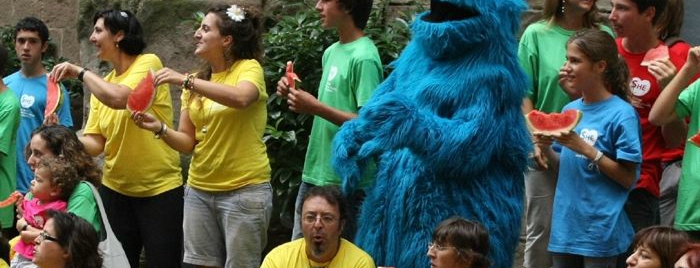

The SI! Program is a school intervention designed to promote cardiovascular health from the pre-schooling stage in aspects referred to as healthy eating habits, knowledge of the body and heart, physical activity, and the management of emotions. The aim of this program is to demonstrate that the acquisition of healthy habits from childhood lessens the risk of cardiovascular diseases and improves quality of life in adulthood. Nearly 15 investigators of the National Cardiovascular Research Centre and Mount Sinai Hospital have evaluated the efficacy of the SI! Program in 2,062 boys and girls aged 3, 4 and 5 years old in 24 schools in Madrid (Spain), during the school years 2011-2012 and 2013-2014. To final results of the study showed implementation of the SI! Program in all three courses to significantly improve knowledge, attitudes and healthy habits among the children, with improvement of the obesity markers. At present, the SI! Program has been extended to over 125 schools in the Community of Madrid, Catalonia and Galicia.
The main cardiovascular risk factor in both adults and children is obesity and its associated conditions (diabetes and arterial hypertension), resulting from poor eating habits and a low level of physical activity [1]. The epidemiological data indicate that cardiovascular risk factors are present from increasingly on early ages, and that the poor eating habits acquired in childhood persist on into adult life [2, 3]. In this regard, the studies found in the literature indicate that Spanish children currently have an unhealthy lifestyle, including poor eating habits and low levels of physical activity, resulting in a high prevalence of childhood obesity (Figure 1) [4-6].
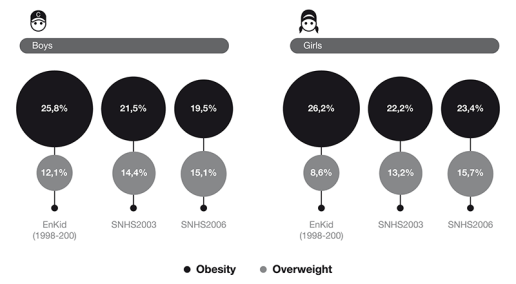
Figure 1. Prevalence of obesity and overweight in children between 5-9 years in Spain (1998-2006).
In addition, other cardiovascular risk factors such as alcohol abuse, smoking and the use of other drugs – typically studied in adult populations – are also beginning to manifest in the Spanish (pre)-adolescent population [7, 8]. In this regard, Spanish boys and girls have high levels of addiction to substances such as alcohol and tobacco. In 2008, an epidemiological study in students between 14-18 years of age showed that 81.2% had consumed alcohol at some time, and that 44.6% had smoked [9].
Public health research has shown that health-promoting initiatives should start in childhood in order to secure lasting and effective behavioral changes. School interventions are the most effective instrument in this regard [10-13].
The SI! Program (Comprehensive Health) was developed under the premise that the best way to prevent cardiovascular disease and improve quality of life in adults is to combat the underlying risk factors through the acquisition of healthy living habits in childhood. In the year 2011, with the collaboration of the National Cardiovascular Research Centre (Madrid, Spain) and Mount Sinai Hospital (New York, USA), the program launched a randomized, controlled, three-year study in 24 public schools in Madrid with the aim of promoting cardiovascular health in four basic and directly related areas: the acquisition of healthy eating habits, physical activity, knowledge of the body and heart, and management of emotions and promotion of social responsibility, as protective measures against addictions and the consumption of substances foreign to the body (tobacco, alcohol and drugs) (Figure 2) [14]. The study obtained measurements in 2,062 children between 3-5 years of age.
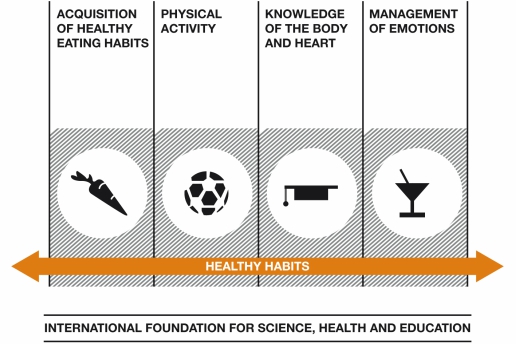
Figure 2. The SI! Program intervenes in four basic and inter-related dimensions: healthy eating habits, physical activity, knowledge of the body and heart, and management of emotions and promotion of social responsibility, as protective measures against addictions and the consumption of substances foreign to the body (tobacco, alcohol and drugs).
The SI! Program intervened at four levels: school environment, teachers, families and pupils. The intervention targeted to the school environment comprised periodic communications sent by the SI! Program team to the center managing board and coordinator for subsequent distribution among the teachers. The intervention at teacher level on one hand aimed to enhance awareness among the teaching staff of the reality of cardiovascular disease and of the importance of teachers in contributing to the acquisition of healthy habits in the school population, and on the other hand intended to train teachers in healthy habits and the methodology to be used in conducting the program in the classroom – providing materials and working tools for the pupils. During the study, the centers in charge of imparting the contents received training accredited (credits: 30 hours) by the different Autonomous Community administrations. The program contents were contrasted by educational psychologist and by the teachers of each center, and were adjusted to the school curriculum. Lastly, considering the key role played by families in educating their children in healthy habits, the study placed special emphasis on the need to implicate the families in order to achieve changes in routines and habits in the family environment [14].
One-half of the schools participating in the study were randomly assigned to the intervention group. The students in this group completed a minimum of 30 hours of activities per academic course referred to the elements of the program (20 lecture hours referred to eating habits, physical activity and the human body, and 10 hours referred to the management of emotions – together with weekend activities with the family, other activities involving the entire school, and annual health fairs and events). The students in the remaining schools served as controls and continued their normal curricular activities (Figure 3) [14].
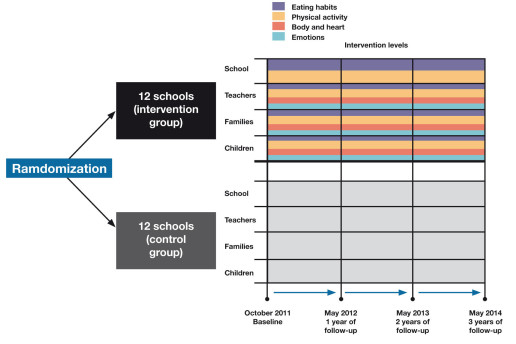
Figure 3. Design of the SI! Program in pre-school children: A randomised (1:1), controlled three-year study was started in 2011 in 24 schools to assess the impact of the SI! Program in boys and girls between 3-5 years of age, with the obtainment of measurements in 2062 pupils [14].
As primary endpoint of the intervention, an evaluation was made of the changes in knowledge, attitudes and habits referred to health among the children in the intervention group versus the control group (scores ranging from 0-80). An analysis was also made of the effect of the intervention upon obesity markers such as waist circumference or percentage of adipose tissue, which are both directly related to cardiovascular health. After three years of follow-up, the general score on knowledge, attitudes and habits referred to health in the intervention group was found to be 4.9% higher than in the control group (Figure 4). The greatest impact in terms of knowledge was recorded during the first year, whereas changes in habits – specifically healthy eating habits and physical activity- increased with the time over the three years. The general improvements were largely circumscribed to improvements in the physical activity component. In addition, and as a result of the above, the SI! Program was found to be effective and feasible in improving the obesity markers in children (reduction of the triceps skin fold z-score of at least 0.1) [14].
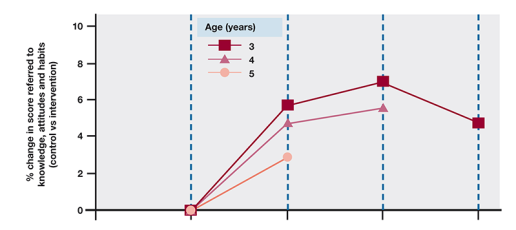
Figure 4. Results of the SI! Program in pre-school children: After three years of follow-up, the general score on knowledge, attitudes and habits referred to health in the intervention group was found to be 4.9% higher than in the control group. A peak was observed (7.1% improvement in the intervention group versus the control group) in the second year [14].
In conclusion, the SI! Program contributes new and valuable information on the benefits of an early intervention targeted to pre-school children, referred to the promotion of healthy life habits. According to Dr. Fuster, “the basis of the program is the fact that it is between 3-6 years of age when we develop our future behavior as adults. Cardiovascular disease has a lot to do with behavior, and so here we have our window of opportunity”. This study moreover uses an innovating design, since it expands the role of physicians to also encompass the teaching community. On the other hand, it involves a protocol with structured evaluation – something that is usually lacking in community public health interventions. The program moreover coordinates families and educators through the pupils, which may serve to guarantee the sustainability of the intervention.
In Madrid, a randomized study was carried out from 2014 to 2020 in the primary education stage (children aged 6 to 11 years). Forty-eight public schools from 16 municipalities in the south of Madrid participated, with a total of 1,770 children, their families and teachers [15]. A randomization was carried out in 4 groups of schools with different exposure to the SI! Program. The aim of this design was to evaluate the effect of the SI! Program at different times and with different intensities. Additionally, the children participating in the randomized study of the SI! Program between 2011 and 2014 were followed up. In this way, it will be possible to evaluate the effect of the SI! Program in the long term and with different intensity of exposure to the intervention.
The last educational stage of the SI! Program has been applied in Secondary Education through a randomized design from 2017 to 2021. The project, awarded by the Marató of TV3 in collaboration with the University of Barcelona, the National Center for Cardiovascular Research and SHE-la Caixa Foundation, has included 1,300 adolescents aged 12 to 16 years from 24 public high schools in the north of Madrid, Barcelona and BaixLlobregat [16]. Most early adolescents enrolled in the SI! Program for Secondary School trial had a poor or intermediate cardiovascular health at baseline, with just 11% of them demonstrating ideal cardiovascular health [17]. The lowest scoring individual component was dietary habits, with only 0.6% of adolescents meeting ideal recommendations. Self-reported low-income family status, low parental education, and migrant condition were associated with worse adolescent cardiovascular health. Health promotion interventions should be implemented at young ages, with a particular focus on dietary habits and low socioeconomic settings.
References
- Caballero B.Epidemiol Rev, 2007, 29:1-5. The global epidemic of obesity: an overview.
- Fuster V and Kelly BB. Washington, DC: National Academies Press, promoting cardiovascular health in the developing world: A critical challenge to achieve global health.
- Carlsson AC et al. Int J Cardiol, 2013, 168(2):946-52.Seven modifiable lifestyle factors predict reduced risk for ischemic cardiovascular disease and all-cause mortality regardless of body mass index: a cohort study.
- Rodriguez-Artalejo F et al. Eur J Clin Nutr, 2002, 56(2):141-8. Dietary patterns among children aged 6-7 y in four Spanish cities with widely differing cardiovascular mortality.
- Roman B et al. Nutr Rev, 2009, 67 Suppl 1:S94-8.Physical activity in children and youth in Spain: future actions for obesity prevention.
- Martinez-Vizcaino V et al. Public Health Nutr, 2009, 12(7):1015-8.Trends in excess weight and thinness among Spanish schoolchildren in the period 1992-2004: the Cuenca study.
- Garces C and de Oya M. Rev EspCardiol, 2007, 60(5):517-24.[Cardiovascular risk factors in children. Main findings of the Four Provinces study].
- Martinez Vizcaino V et al. Med Clin (Barc), 2006, 126(18):681-5.[Prevalence of obesity and trends in cardiovascular risk factors among Spanish school children, 1992-2004: the Cuenca (Spain) study].
- Ministerio de Sanidad y Política Social. Delegación del Gobierno para el Plan Nacional sobre Drogas. Informe de la encuesta estatal sobre uso de drogas en estudiantes de Enseñanzas Secundarias (ESTUDES) 2008.
- Gubbels JS et al. Int J BehavNutr Phys Act, 2012, 9:77.Clustering of energy balance-related behaviors in 5-year-old children: lifestyle patterns and their longitudinal association with weight status development in early childhood.
- Mishra S et al. J Basic Clin PhysiolPharmacol, 2013, 18:1-8.Association of diet and anthropometric measures as cardiovascular modifiable risk factors in young adults.
- Story M. Int J ObesRelatMetabDisord, 1999, 23 Suppl 2:S43-51.School-based approaches for preventing and treating obesity.
- Williams CL et al. Circulation, 2002, 106(1):143-60.Cardiovascular health in childhood: A statement for health professionals from the Committee on Atherosclerosis, Hypertension, and Obesity in the Young (AHOY) of the Council on Cardiovascular Disease in the Young, American Heart Association.
- Peñalvo JL, Fuster V et al. J Am Coll Cardiol, 2015, 66 (14):1525-1534.The SI! Program for cardiovascular health promotion in early childhood: A cluster randomized trial.
- Santos-Beneit G, Fuster V et al. Heart J, 2019, 210:9-17. Rationale and Design of the SI! Program for Health Promotion in Elementary Students Aged 6 to 11 years: A Cluster Randomized Trial.
- Fernández-Jiménez R, Fuster V et al. Heart J, 2019, 215:27-40. Rationale and design of the school-based Program SI! To face obesity and promote health among Spanish adolescents: a cluster-randomized controlled trial.
- Fernández-Jiménez R, Fuster V et al. J. Prev. Cardiol, 2020, doi:10.1093/eurjpc/zwaa096. Prevalence and correlates of cardiovascular health among early adolescents enrolled in the SI! Program in Spain: a cross-sectional analysis.


